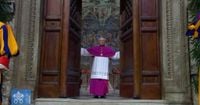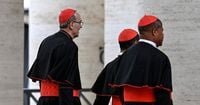A historic conclave commenced on May 7, 2025, as 133 cardinal electors from 71 countries gathered in the Vatican to elect a successor to Pope Francis, who passed away on April 21. This conclave marks a significant moment in the Catholic Church, being the largest in history, with approximately 80% of the electors nominated by the late pontiff.
At 10:00 AM, a mass known as Pro eligendo Papa was held at St. Peter's Basilica, setting the spiritual tone for the proceedings. Following this, at 4:30 PM, the cardinals processed to the Sistine Chapel, where they took an oath of secrecy, a crucial step in the conclave process. As Cardinal Pietro Parolin led the proceedings, the doors to the chapel were closed, marking the official start of the conclave.
The electors, who must be under 80 years old, include notable figures such as Stanisław Ryłko, Kazimierz Nycz, Konrad Krajewski, and Grzegorz Ryś from Poland. This conclave is particularly noteworthy as it features cardinals from 12 new countries, including Haiti and South Sudan, reflecting a broader representation within the Church. The youngest elector is 45-year-old Cardinal Mykoła Byczok from Ukraine.
To successfully elect a new pope, a two-thirds majority is required, which translates to 89 votes out of the 133 electors. If the first vote does not yield a decision, the cardinals will conduct additional votes, with the first one scheduled for Wednesday evening. Vatican spokesman Matteo Bruni indicated that smoke signaling the results will not appear before 7:00 PM on the same day.
Starting Thursday, May 8, two votes will be held each morning and afternoon. If a pope is elected during the first morning vote, white smoke will billow from the chapel around 10:30 AM. If a second vote is necessary, the color of the smoke will be determined around noon. For afternoon votes, white smoke is expected around 5:30 PM and 7:00 PM, depending on the outcome.
If, after 13 votes, no pope has been elected, a 24-hour break will be observed. This protocol, established by Pope Benedict XVI in 2013, mandates that after 34 votes without a decision, electors must choose between the two candidates who received the most votes.
As the conclave progresses, the world watches closely. Hundreds of people have gathered in St. Peter's Square, filled with anticipation for the announcement of the new pope. Flags from various nations wave among the crowd, showcasing the global interest in this pivotal moment for the Catholic Church.
The conclave's atmosphere is charged with both reverence and urgency. The cardinals are isolated, cut off from the outside world to ensure confidentiality in their deliberations. They are prohibited from any form of communication with outsiders, a rule that extends to Vatican staff involved in the conclave.
In the days leading up to the conclave, the cardinals discussed the continuation of several reforms initiated by Pope Francis, including efforts to combat abuse, enhance economic transparency, and reorganize the Roman Curia. These discussions reflect the ongoing evolution within the Church and the challenges it faces in the modern world.
The Sistine Chapel, with its iconic Michelangelo frescoes, serves as the backdrop for this historic event. The tradition of signaling the election of a new pope with smoke dates back over 200 years, with black smoke indicating no decision and white smoke confirming a successful election. This practice was formalized in 1914, adding a clear visual cue to the process.
As the cardinals prepare for their first vote, the world holds its breath, waiting for the moment when the smoke will rise above the chapel, signaling the dawn of a new papacy. The outcome of this conclave will not only shape the future of the Catholic Church but also influence its role on the global stage.
The conclave's logistics have been meticulously planned to accommodate the record number of participants, with additional accommodations arranged due to the overflow of cardinals. The Vatican's commitment to maintaining security and confidentiality is paramount during this critical time.
As the ceremony unfolds, the anticipation builds. Will the cardinals choose a leader who will continue the path set by Pope Francis, or will they opt for a different direction? The answer lies within the walls of the Sistine Chapel, where history is being made.
In summary, the conclave of 2025 is a historic event characterized by its unprecedented number of electors and the significant reforms at stake. As the world watches, the cardinals are poised to make a decision that will resonate throughout the Catholic Church and beyond.



